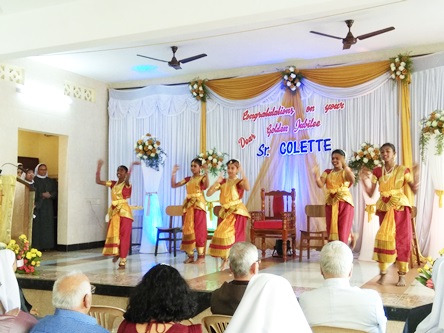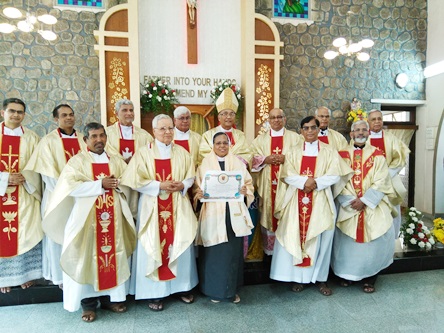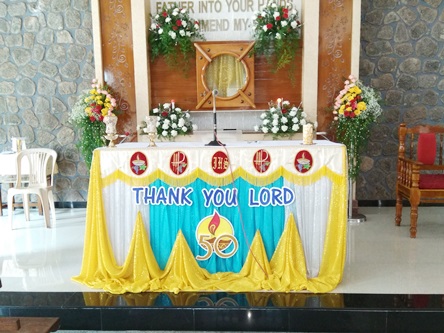News & Events

Golden jubilee celebration of the religious profession of Sr. Colette Menezes in Nanthoor, Calvary Shrine, Mangalore celebrated on 2nd February




Order of the Most Holy Saviour of St Bridget (O.Ss.S)
1. The Order of the Most Holy Saviour of St. Bridget, was founded by St Bridget in 14th centurary and was canonically approved by Pope Urban V 1370 in Vadstena Sweden and revived in Rome by St. Maria Elizabeth Hesselblad on September 8, 1911.
2. Patroness & Foundress: St. Bridget of Sweden. Feast on 23rd July. The Titular feast of the Order is on 6th August, the transfiguration of our Lord.
3. Patroness: St. Bridget (1303-1373) The most celebrated saint of Sweden, co-patroness of Europe and a great mystic was the daughter of the knight Birger Person of the family of Finsta, governor and lawspeaker of Uppland, and one of the richest land owners of the country, and her Mother was Ingeborg, who was a close relative of the Swedish king.
She was born in June 1303. In 1316, at the age of 14 she married Ulf Gudmarson of the family of Ulvåsa, Lord of Närke, and lovingly raised eight children, Her second daughter is now honored as St. Catherine of Sweden. Bridget and her husbabd were known for their works of charity. In 1341 she and her husband went on pilgrimage to Santiago de Compostela. Shortly after their return, Ulf died at the Cistercian Alvastra Abbey in Östergötland. After this loss, Birgitta became a member of the Third Order of St Francis and devoted herself wholly to a life of prayer and caring for the poor and the sick. It was about this time that the Lord revealed to her Hs plan for the future mission of establishing the religious community which was to become the Order of the Most Holy Saviour, or the Brigittines, whose principal house at Vadstena was later richly endowed by King Magnus IV of Sweden and his queen. One distinctive feature of the pre-Reformation houses of the Order was that they were double monasteries, with both men and women forming a joint community, though with separate cloisters. They were to live in poor convents and to give all surplus income to the poor. When Bridget learned of an epidimic in Rome, she made a pilgrimage there to assist the sick and the dying.
The middle ages which were marked by division and strife, by endless fratricidal war, economic and political instability, religious disunity and threat of schisms in the Catholic Chruch. By her very nature, but even more by her vocation, Bridget was a person of reoconciliation and peace. Her family background, her residence at the royal court of Sweden as an advisor in the Kings government and her travels far and wide through the nations of Europe formed her knowledge of the problems of trhe diplomacy, politics and the governmnet of peoples. This gave her great insight into the situation in Europe and the problems of the Chruch, such that she did everything within her power to bring Pope back from Avignon to the see of Rome. On the ocassion of the 6th centinary of her canonisation Pope St. John Paul second described St. Bridget as a prophet for new times because, in the midst of the turtmoil of the human events of her age and down through the centuries since, her voice constantly calls us back to an inner renewal that is rooted deeply in the unchanging values of the Gospel.
4. Foundress: St Maria Elizabeth Hesselblad (1870-1957) Born in Sweden of Lutheran faith, she emigrated to America at the age of 18 in order to help her family’s economic paroblems. Through her contact with suffering and illness at the Roosvelt hospital where she worked as nurse, her human and spiritual senitivity was deepened and conformed to that of her comptriot Bridget, a spirituality based on love of the crucified.
Having converted to the Catholic faith on August 15,1902 and surmounting many obstacles and illnesses, she took the Bridgettine habit at the Casa di S. Brigida in Rome which was then occupied by Carmelite nuns. Under the inspiration of the Holy Spirit, revived the Bridgettine Order maintaining its tradition of conptemplation, solemn liturgical celebration, and their apostolate and constant devotion to work for the unity of Church. This new branch from the old Bridgetttine lineage, was born on September 8,1911 and was given definitive approval by the Holy See on 2nd December 1940. During and after the Second World War, Maria Elizabeth performed great works of charity on behalf of the poor and those who suffered because of racial laws; she promoted a movement for peace that involved Catholics and non-Catholic’s; she multiplied her ecumenical endeavours and for many people who belonged to other religions or other Christian confessions, she was part of their journey towards the Catholic Church.
On other occasions she said, "Our religious houses must be formed after the example of Nazareth: prayer, work, sacrifice. The human heart can aspire to nothing greater."
Throughout her life she remained faithful to what she had written in 1904: "Dear Lord, I do not ask to see the path. In darkness, in anguish and in fear, I will hang on tightly to your hand and I will close my eyes, so that you know how much trust I place in you, Spouse of my soul." Hope in God and in His providence supported her in every moment, especially in times of testing, solitude and the cross. She put the things of Heaven before the things of earth, God’s will before her own, the good of her neighbour before her own benefit.
Contemplating the infinite love of the Son of God, who sacrificed Himself for our salvation, she fed the flame of love in her heart, as manifested by the goodness of her works. Repeatedly to her daughters she said, "We must nourish a great love for God and our neighbors; a strong love, an ardent love, a love that burns away imperfections, a love that gently bears an act of impatience, or a bitter word, a love that lets an inadvertence or act of neglect pass without comment, a love that lends itself readily to an act of charity." Maria Elizabeth was like a garden in which the sun of charity brought to bloom the flowers of the spiritual and corporal works of mercy. She was filled with care and concern for her Sisters, for the poor, the sick, the persecuted Jewish people, for priests, for the children to whom she taught Christian doctrine, for her family and for the people of Sweden and Rome. She was a humble Sister and most obliging to all who sought her help. She always felt a sense of duty and great joy in sharing with others the gifts she had received from the Lord, and this she did with gentleness, graciousness and simplicity. She was prudent in her work for the Kingdom of God, in her speaking, acting, advising and correcting. She had great respect for the religious freedom of non-Christians and non-Catholics, whom she received gladly under her roof. She practiced justice towards God and neighbour, temperance, self-control, reserve, detachment from the honours and things of the world, humility, chastity, obedience, fortitude in tribulation, perseverance in her praise and service of God, faithfulness to her religious consecration. I n prayer and peaceful submission to God’s will she prepared herself for the final meeting with the Divine Spouse, who called her to Himself in the early hours of 24 April 1957, aged 87. The reputation for holiness which surrounded her in life increased after her death, and almost immediately the Vicariate of Rome began the cause for Beatification.
St. Maria Elizabeth Hesselblad is also recognized as a Righteous Among the Nations due to her efforts in World War II saving the lives of Jewish people during the genocide of the Holocaust. Pope John Paul II Beatified her on April 9, 2000 and Pope Francis canonized her on June 5, 2016.
5. Charism, Apostolate, Spirituality: “Father may they all be one” Unity as the distictive goal of the Order, shapes the prayer intentions, particularly in community prayer, and works of penance. By the complete offering of their lives to God, the Bridgettines Sisters intend to effect: Reparation offered to God for the separtion of many peoples or large parts of thereof from the one fold of Christ, the Roman Catholic church.
Apostolic concern of the Order includes the missionary activity of the Church, with an appropriate participation of it’s members in the respective areas (A.G.40). Among the works proper to the Order primary importance is given to hospitality with an ecumenical aim.
6. Founding and Growth of the Congregation: In Rome Maria Elizabeth received the Sacrament of Confirmation and she clearly perceived that she was to dedicate herself to the unity of Christians. She also visited the church and house of Saint Bridget of Sweden (+ 1373), and came away with a deep and lasting impression: "It is in this place that I want you to serve me." She returned to the United States but, her poor health notwithstanding, she left everything and on 25 March 1904 she settled in Rome at the Casa di Santa Brigida, receiving a wonderful welcome from the Carmelite Nuns who lived there. In silence and in prayer she made great progress in her knowledge and love of Christ, fostered devotion to Saint Bridget and Saint Catherine of Sweden, and nourished a growing concern for her people and the Church.
In 1906 Pope Saint Pius X allowed her to take the habit of the Order of the Most Holy Saviour of Saint Bridget and profess vows as a spiritual daughter of the Swedish saint. In the years that followed she strove to bring back to Rome the Order of the Most Holy Saviour, and to that end she visited the few existing Brigettine monasteries in Europe, an experience that brought joys, disappointments and no concrete help. Her dream of bringing to birth a Brigettine community in Rome that was made up of members coming from monasteries of ancient observance, was not realized. However Divine Providence, in ways that were quite unexpected, enabled a new branch to grow from the ancient Brigettine trunk. In fact, on the September 8, 1911, Maria Elizabeth welcomed three young English postulants and refounded the Order of the Most Holy Saviour of Saint Bridget, whose particular mission was to pray and work, especially for the unity of Scandinavian Christians with the Catholic Church. In 1931 she experienced the great joy of receiving the Holy See's permission to have permanent use of the church and house of Saint Bridget in Rome. These became the centre of activity for the Order which, driven on by its missionary zeal, also established foundations in India (1937).
During and after the Second World War, Maria Elizabeth performed great works of charity on behalf of the poor and those who suffered because of racial laws; she promoted a movement for peace that involved Catholics and non-Catholics; she multiplied her ecumenical endeavours and for many people who belonged to other religions or other Christian confessions, she was part of their journey towards the Catholic Church. More communities were opened in Europe, United States, Mexico, Poland and India.
7. In India: on April 27, 1937 the first group of young and zealous 10 Italian Bridgttine sisters along with 2 Indian sisters who have been trained in Rome by Mother Elizabeth herself arrived in Marikunnu, in the dioceses of Calicut under the leadership of Fr Beretta S.J. Although the first missionary community in Marikunnu had many deprivations and initial difficulties it was called the power house of the diocese of Calicut. Perpetual adoration of the Blessed Sacrament was the characteristic of the community and the sisters also had the care of orphanage. The contemplative apostolic style of life attracted many vocations and the strength of the community was growing rapidly. There are 270 sisters and 21 established houses in India today. The Bridgettines reach out to the society through pastoral assistance, dispensaries, women Welfre Centres, kindergartens, technical centres, hostels for students and working women, homes for children and various social works. Convent of St. Birgitta at Brunton Road, Bangalore remains as the regional house / delegation house in India.
8. Global Presence of the Bridgettines: The total No. of Bridgettine Sisters are around 800 spread out in 19 countries and 4 continents. The present Superior General is Sr. Fabia Kattakayam the successor of Sr Tekla Famiglietti.
The Order of SS. Savior of Saint Bridget is present today in Europe:
Sweden: Djursholm, Falun; Norway: Heimdal; Finland: Turku, Stella Maris; Denmark: Maribo; Estonia: Tallinn; Poland: Czestochowa, Gdansk; Germany: Bremen; Netherlands: Weert; England: Iver Heath, Birmingham, Wales Holywell; Switzerland: Lugano and Italy: Rome, Piazza Farnese, Via delle Isole, Olgiata, Rome, Farfa Sabina, Assisi, Naples-Camaldoli.
In the Middle East: Palestine: Bethlehem and Israel: Jerusalem
In North America: U.S.: Darien
In Central America: Mexico: Tacambaro, Mexico City, La Paz, Manzanillo, Guadalajara and Cuba: Havana, Pinar del Rio
In Asia: India: Marikunnu, Bangalore, Kalamassery, Pallavaram, Mysore, Nantoor, Trivandrum, Puttur, Sipcot, Goa, Chikmagalur, Kurnool, Belgaum, Mumbai, Kannur, Amachal, Visakhapatnam and Sabbavaram (Andhra Pradesh), New Delhi, Bhagalpur and Kabirpur (Bihar); Poomala (Wynad) and Solur ( Bangalore)
Philippines: Tagaytay, Montevista; and Indonesia: Bali, Maumere
There are four saints, 1 blessed, and 3 servants of God.
• St. Bridget of Sweden Feast on 23rd July.
• St. Catherine of Sweden Feast on August 2nd
• St. Richard Reynolds (Bridgettine Martyr) Feast. May 4th
• St. Elisabeth Hesselblad Feast June 4th Feast
• Blessed Francesca and Anna Maria Martyrs Feast
• Servant of God Mother Riccarda
• Servant of God Mother M. Catherine Flanagan
• Servant of God Sister M. Maddalena Moccia
Society of the Bridgettine Sisters
Convent of St. Birgitta
10- Brunton Road
BANGALORE 560025
08025598863
8618123794
Back






 The Beginning
The Beginning